JHAH Dental Turnaround: Findings, Discussions, and Strategy Plan
VerifiedAdded on 2023/06/09
|21
|8768
|67
Case Study
AI Summary
This case study presents findings and discussions related to the turnaround strategy of the JHAH dental department in Saudi Arabia. It analyzes the external and internal environment using PEST, SWOT, and market analysis, incorporating data from interviews and company reports. The study identifies key issues such as a lack of shared vision, technology deficits, human capital challenges, and resistance to change. It explores stakeholder positions, organizational structure inefficiencies, and the impact of external factors like government regulations and economic conditions. The research highlights the need for a comprehensive turnaround roadmap with deliverables for each phase, emphasizing change management tools to enhance performance and achieve a successful turnaround, while addressing the need for better human capital management and strategic alignment within the organization. Desklib provides access to this case study along with a vast library of past papers and solved assignments.
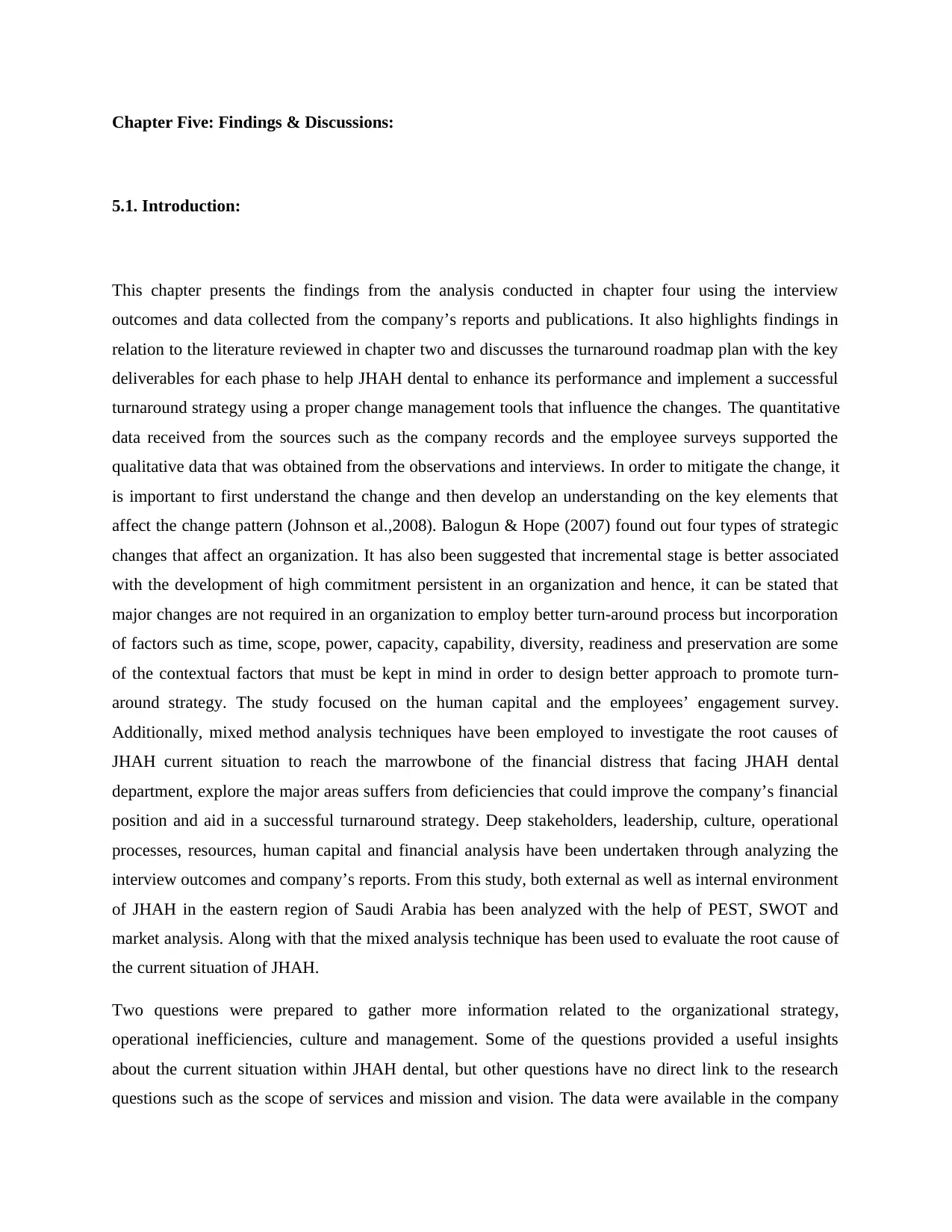
Chapter Five: Findings & Discussions:
5.1. Introduction:
This chapter presents the findings from the analysis conducted in chapter four using the interview
outcomes and data collected from the company’s reports and publications. It also highlights findings in
relation to the literature reviewed in chapter two and discusses the turnaround roadmap plan with the key
deliverables for each phase to help JHAH dental to enhance its performance and implement a successful
turnaround strategy using a proper change management tools that influence the changes. The quantitative
data received from the sources such as the company records and the employee surveys supported the
qualitative data that was obtained from the observations and interviews. In order to mitigate the change, it
is important to first understand the change and then develop an understanding on the key elements that
affect the change pattern (Johnson et al.,2008). Balogun & Hope (2007) found out four types of strategic
changes that affect an organization. It has also been suggested that incremental stage is better associated
with the development of high commitment persistent in an organization and hence, it can be stated that
major changes are not required in an organization to employ better turn-around process but incorporation
of factors such as time, scope, power, capacity, capability, diversity, readiness and preservation are some
of the contextual factors that must be kept in mind in order to design better approach to promote turn-
around strategy. The study focused on the human capital and the employees’ engagement survey.
Additionally, mixed method analysis techniques have been employed to investigate the root causes of
JHAH current situation to reach the marrowbone of the financial distress that facing JHAH dental
department, explore the major areas suffers from deficiencies that could improve the company’s financial
position and aid in a successful turnaround strategy. Deep stakeholders, leadership, culture, operational
processes, resources, human capital and financial analysis have been undertaken through analyzing the
interview outcomes and company’s reports. From this study, both external as well as internal environment
of JHAH in the eastern region of Saudi Arabia has been analyzed with the help of PEST, SWOT and
market analysis. Along with that the mixed analysis technique has been used to evaluate the root cause of
the current situation of JHAH.
Two questions were prepared to gather more information related to the organizational strategy,
operational inefficiencies, culture and management. Some of the questions provided a useful insights
about the current situation within JHAH dental, but other questions have no direct link to the research
questions such as the scope of services and mission and vision. The data were available in the company
5.1. Introduction:
This chapter presents the findings from the analysis conducted in chapter four using the interview
outcomes and data collected from the company’s reports and publications. It also highlights findings in
relation to the literature reviewed in chapter two and discusses the turnaround roadmap plan with the key
deliverables for each phase to help JHAH dental to enhance its performance and implement a successful
turnaround strategy using a proper change management tools that influence the changes. The quantitative
data received from the sources such as the company records and the employee surveys supported the
qualitative data that was obtained from the observations and interviews. In order to mitigate the change, it
is important to first understand the change and then develop an understanding on the key elements that
affect the change pattern (Johnson et al.,2008). Balogun & Hope (2007) found out four types of strategic
changes that affect an organization. It has also been suggested that incremental stage is better associated
with the development of high commitment persistent in an organization and hence, it can be stated that
major changes are not required in an organization to employ better turn-around process but incorporation
of factors such as time, scope, power, capacity, capability, diversity, readiness and preservation are some
of the contextual factors that must be kept in mind in order to design better approach to promote turn-
around strategy. The study focused on the human capital and the employees’ engagement survey.
Additionally, mixed method analysis techniques have been employed to investigate the root causes of
JHAH current situation to reach the marrowbone of the financial distress that facing JHAH dental
department, explore the major areas suffers from deficiencies that could improve the company’s financial
position and aid in a successful turnaround strategy. Deep stakeholders, leadership, culture, operational
processes, resources, human capital and financial analysis have been undertaken through analyzing the
interview outcomes and company’s reports. From this study, both external as well as internal environment
of JHAH in the eastern region of Saudi Arabia has been analyzed with the help of PEST, SWOT and
market analysis. Along with that the mixed analysis technique has been used to evaluate the root cause of
the current situation of JHAH.
Two questions were prepared to gather more information related to the organizational strategy,
operational inefficiencies, culture and management. Some of the questions provided a useful insights
about the current situation within JHAH dental, but other questions have no direct link to the research
questions such as the scope of services and mission and vision. The data were available in the company
Paraphrase This Document
Need a fresh take? Get an instant paraphrase of this document with our AI Paraphraser
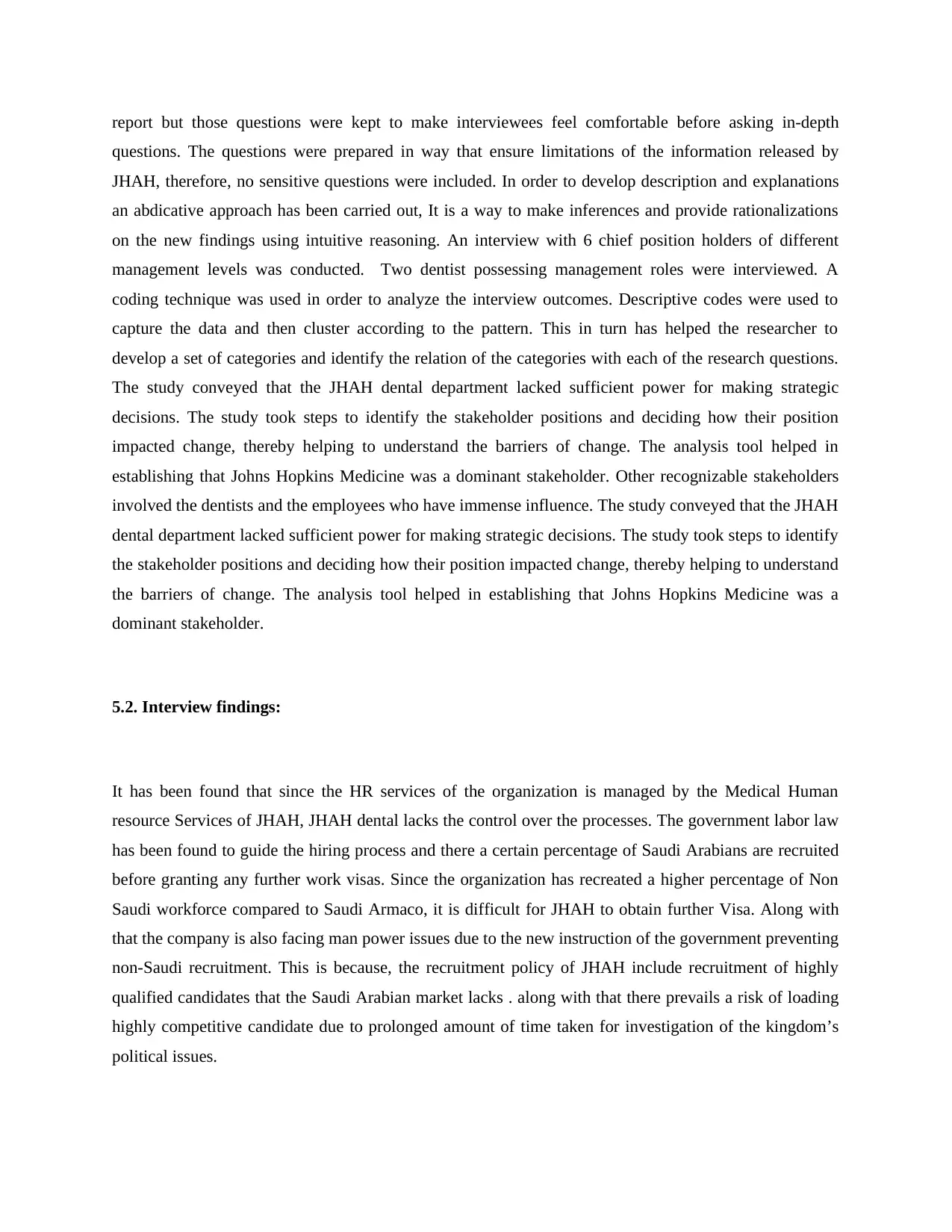
report but those questions were kept to make interviewees feel comfortable before asking in-depth
questions. The questions were prepared in way that ensure limitations of the information released by
JHAH, therefore, no sensitive questions were included. In order to develop description and explanations
an abdicative approach has been carried out, It is a way to make inferences and provide rationalizations
on the new findings using intuitive reasoning. An interview with 6 chief position holders of different
management levels was conducted. Two dentist possessing management roles were interviewed. A
coding technique was used in order to analyze the interview outcomes. Descriptive codes were used to
capture the data and then cluster according to the pattern. This in turn has helped the researcher to
develop a set of categories and identify the relation of the categories with each of the research questions.
The study conveyed that the JHAH dental department lacked sufficient power for making strategic
decisions. The study took steps to identify the stakeholder positions and deciding how their position
impacted change, thereby helping to understand the barriers of change. The analysis tool helped in
establishing that Johns Hopkins Medicine was a dominant stakeholder. Other recognizable stakeholders
involved the dentists and the employees who have immense influence. The study conveyed that the JHAH
dental department lacked sufficient power for making strategic decisions. The study took steps to identify
the stakeholder positions and deciding how their position impacted change, thereby helping to understand
the barriers of change. The analysis tool helped in establishing that Johns Hopkins Medicine was a
dominant stakeholder.
5.2. Interview findings:
It has been found that since the HR services of the organization is managed by the Medical Human
resource Services of JHAH, JHAH dental lacks the control over the processes. The government labor law
has been found to guide the hiring process and there a certain percentage of Saudi Arabians are recruited
before granting any further work visas. Since the organization has recreated a higher percentage of Non
Saudi workforce compared to Saudi Armaco, it is difficult for JHAH to obtain further Visa. Along with
that the company is also facing man power issues due to the new instruction of the government preventing
non-Saudi recruitment. This is because, the recruitment policy of JHAH include recruitment of highly
qualified candidates that the Saudi Arabian market lacks . along with that there prevails a risk of loading
highly competitive candidate due to prolonged amount of time taken for investigation of the kingdom’s
political issues.
questions. The questions were prepared in way that ensure limitations of the information released by
JHAH, therefore, no sensitive questions were included. In order to develop description and explanations
an abdicative approach has been carried out, It is a way to make inferences and provide rationalizations
on the new findings using intuitive reasoning. An interview with 6 chief position holders of different
management levels was conducted. Two dentist possessing management roles were interviewed. A
coding technique was used in order to analyze the interview outcomes. Descriptive codes were used to
capture the data and then cluster according to the pattern. This in turn has helped the researcher to
develop a set of categories and identify the relation of the categories with each of the research questions.
The study conveyed that the JHAH dental department lacked sufficient power for making strategic
decisions. The study took steps to identify the stakeholder positions and deciding how their position
impacted change, thereby helping to understand the barriers of change. The analysis tool helped in
establishing that Johns Hopkins Medicine was a dominant stakeholder. Other recognizable stakeholders
involved the dentists and the employees who have immense influence. The study conveyed that the JHAH
dental department lacked sufficient power for making strategic decisions. The study took steps to identify
the stakeholder positions and deciding how their position impacted change, thereby helping to understand
the barriers of change. The analysis tool helped in establishing that Johns Hopkins Medicine was a
dominant stakeholder.
5.2. Interview findings:
It has been found that since the HR services of the organization is managed by the Medical Human
resource Services of JHAH, JHAH dental lacks the control over the processes. The government labor law
has been found to guide the hiring process and there a certain percentage of Saudi Arabians are recruited
before granting any further work visas. Since the organization has recreated a higher percentage of Non
Saudi workforce compared to Saudi Armaco, it is difficult for JHAH to obtain further Visa. Along with
that the company is also facing man power issues due to the new instruction of the government preventing
non-Saudi recruitment. This is because, the recruitment policy of JHAH include recruitment of highly
qualified candidates that the Saudi Arabian market lacks . along with that there prevails a risk of loading
highly competitive candidate due to prolonged amount of time taken for investigation of the kingdom’s
political issues.
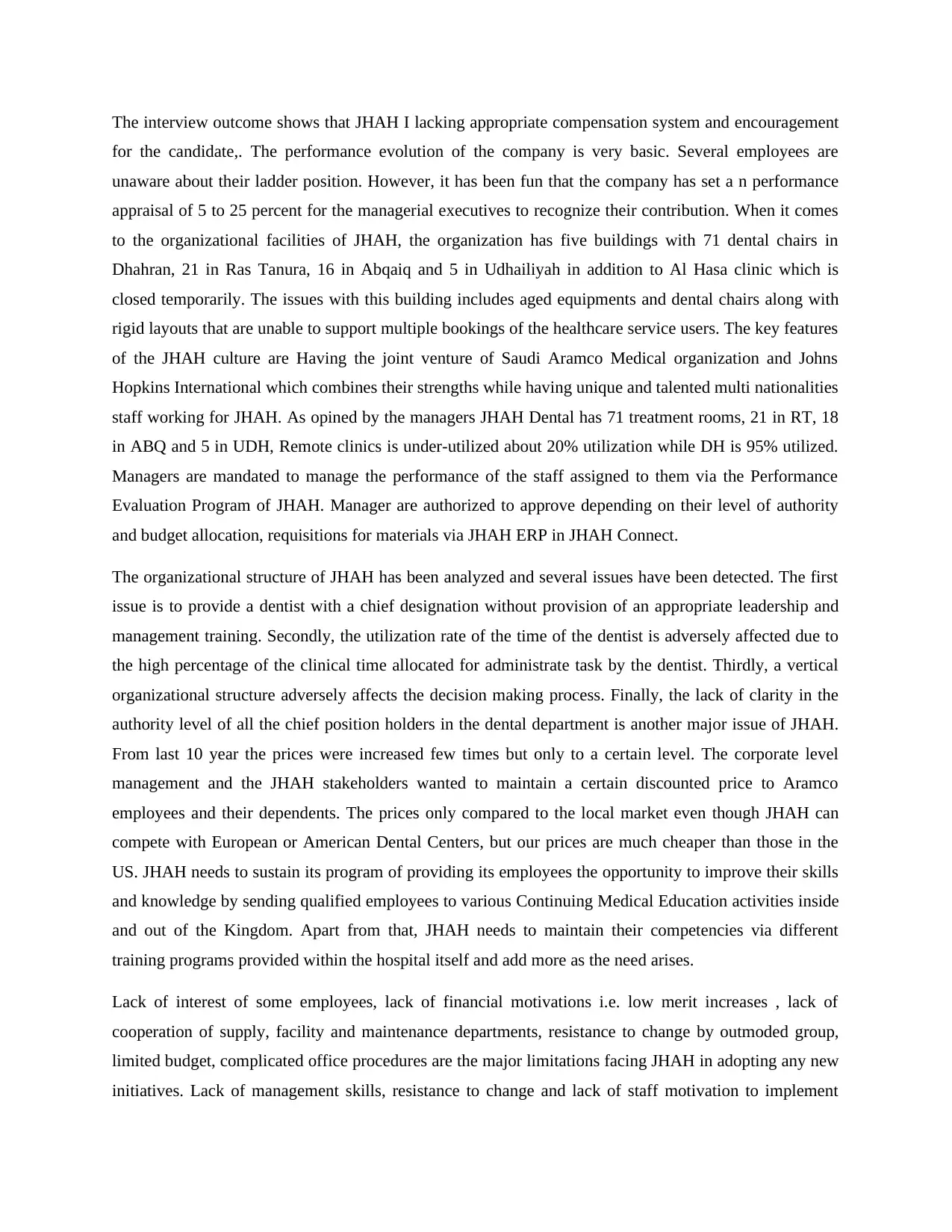
The interview outcome shows that JHAH I lacking appropriate compensation system and encouragement
for the candidate,. The performance evolution of the company is very basic. Several employees are
unaware about their ladder position. However, it has been fun that the company has set a n performance
appraisal of 5 to 25 percent for the managerial executives to recognize their contribution. When it comes
to the organizational facilities of JHAH, the organization has five buildings with 71 dental chairs in
Dhahran, 21 in Ras Tanura, 16 in Abqaiq and 5 in Udhailiyah in addition to Al Hasa clinic which is
closed temporarily. The issues with this building includes aged equipments and dental chairs along with
rigid layouts that are unable to support multiple bookings of the healthcare service users. The key features
of the JHAH culture are Having the joint venture of Saudi Aramco Medical organization and Johns
Hopkins International which combines their strengths while having unique and talented multi nationalities
staff working for JHAH. As opined by the managers JHAH Dental has 71 treatment rooms, 21 in RT, 18
in ABQ and 5 in UDH, Remote clinics is under-utilized about 20% utilization while DH is 95% utilized.
Managers are mandated to manage the performance of the staff assigned to them via the Performance
Evaluation Program of JHAH. Manager are authorized to approve depending on their level of authority
and budget allocation, requisitions for materials via JHAH ERP in JHAH Connect.
The organizational structure of JHAH has been analyzed and several issues have been detected. The first
issue is to provide a dentist with a chief designation without provision of an appropriate leadership and
management training. Secondly, the utilization rate of the time of the dentist is adversely affected due to
the high percentage of the clinical time allocated for administrate task by the dentist. Thirdly, a vertical
organizational structure adversely affects the decision making process. Finally, the lack of clarity in the
authority level of all the chief position holders in the dental department is another major issue of JHAH.
From last 10 year the prices were increased few times but only to a certain level. The corporate level
management and the JHAH stakeholders wanted to maintain a certain discounted price to Aramco
employees and their dependents. The prices only compared to the local market even though JHAH can
compete with European or American Dental Centers, but our prices are much cheaper than those in the
US. JHAH needs to sustain its program of providing its employees the opportunity to improve their skills
and knowledge by sending qualified employees to various Continuing Medical Education activities inside
and out of the Kingdom. Apart from that, JHAH needs to maintain their competencies via different
training programs provided within the hospital itself and add more as the need arises.
Lack of interest of some employees, lack of financial motivations i.e. low merit increases , lack of
cooperation of supply, facility and maintenance departments, resistance to change by outmoded group,
limited budget, complicated office procedures are the major limitations facing JHAH in adopting any new
initiatives. Lack of management skills, resistance to change and lack of staff motivation to implement
for the candidate,. The performance evolution of the company is very basic. Several employees are
unaware about their ladder position. However, it has been fun that the company has set a n performance
appraisal of 5 to 25 percent for the managerial executives to recognize their contribution. When it comes
to the organizational facilities of JHAH, the organization has five buildings with 71 dental chairs in
Dhahran, 21 in Ras Tanura, 16 in Abqaiq and 5 in Udhailiyah in addition to Al Hasa clinic which is
closed temporarily. The issues with this building includes aged equipments and dental chairs along with
rigid layouts that are unable to support multiple bookings of the healthcare service users. The key features
of the JHAH culture are Having the joint venture of Saudi Aramco Medical organization and Johns
Hopkins International which combines their strengths while having unique and talented multi nationalities
staff working for JHAH. As opined by the managers JHAH Dental has 71 treatment rooms, 21 in RT, 18
in ABQ and 5 in UDH, Remote clinics is under-utilized about 20% utilization while DH is 95% utilized.
Managers are mandated to manage the performance of the staff assigned to them via the Performance
Evaluation Program of JHAH. Manager are authorized to approve depending on their level of authority
and budget allocation, requisitions for materials via JHAH ERP in JHAH Connect.
The organizational structure of JHAH has been analyzed and several issues have been detected. The first
issue is to provide a dentist with a chief designation without provision of an appropriate leadership and
management training. Secondly, the utilization rate of the time of the dentist is adversely affected due to
the high percentage of the clinical time allocated for administrate task by the dentist. Thirdly, a vertical
organizational structure adversely affects the decision making process. Finally, the lack of clarity in the
authority level of all the chief position holders in the dental department is another major issue of JHAH.
From last 10 year the prices were increased few times but only to a certain level. The corporate level
management and the JHAH stakeholders wanted to maintain a certain discounted price to Aramco
employees and their dependents. The prices only compared to the local market even though JHAH can
compete with European or American Dental Centers, but our prices are much cheaper than those in the
US. JHAH needs to sustain its program of providing its employees the opportunity to improve their skills
and knowledge by sending qualified employees to various Continuing Medical Education activities inside
and out of the Kingdom. Apart from that, JHAH needs to maintain their competencies via different
training programs provided within the hospital itself and add more as the need arises.
Lack of interest of some employees, lack of financial motivations i.e. low merit increases , lack of
cooperation of supply, facility and maintenance departments, resistance to change by outmoded group,
limited budget, complicated office procedures are the major limitations facing JHAH in adopting any new
initiatives. Lack of management skills, resistance to change and lack of staff motivation to implement
⊘ This is a preview!⊘
Do you want full access?
Subscribe today to unlock all pages.

Trusted by 1+ million students worldwide
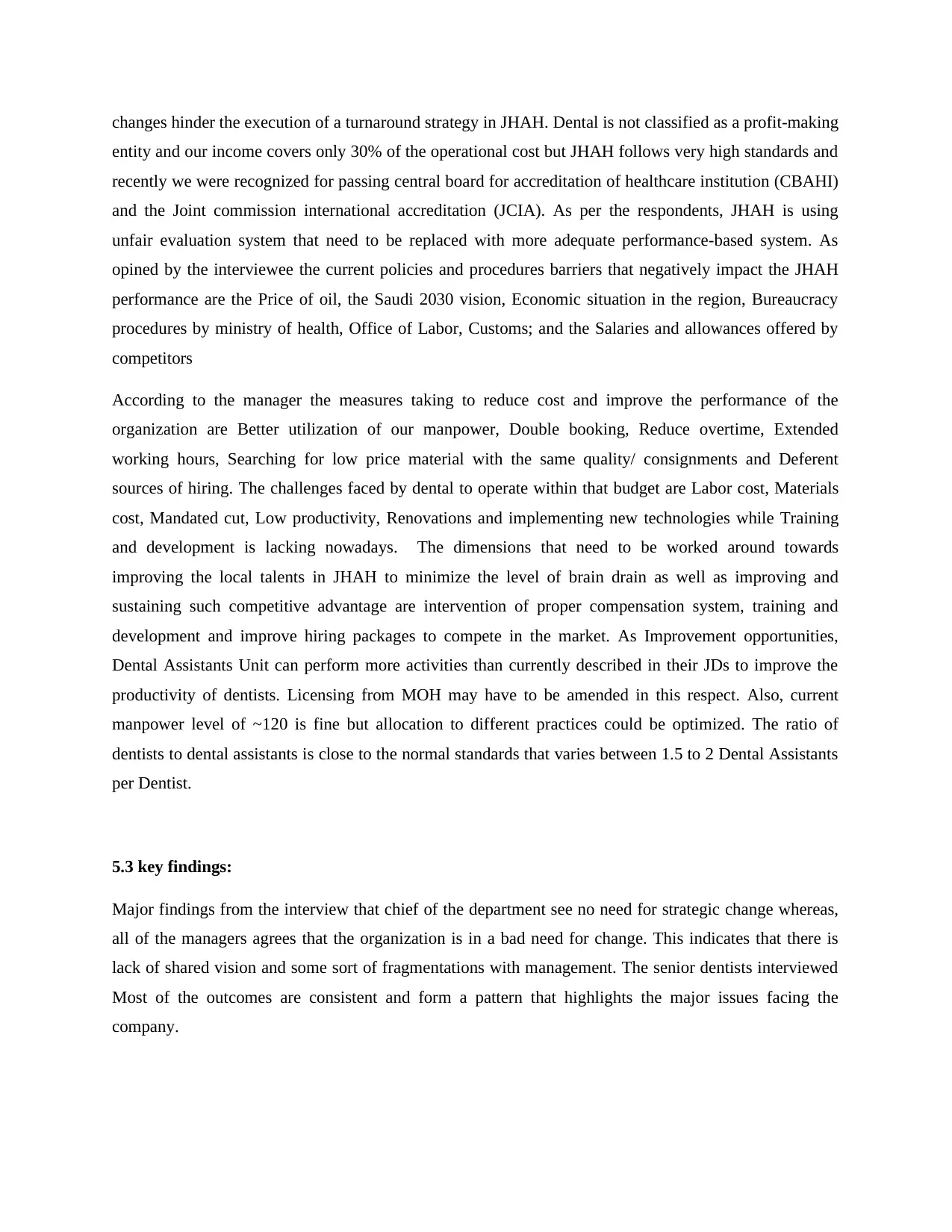
changes hinder the execution of a turnaround strategy in JHAH. Dental is not classified as a profit-making
entity and our income covers only 30% of the operational cost but JHAH follows very high standards and
recently we were recognized for passing central board for accreditation of healthcare institution (CBAHI)
and the Joint commission international accreditation (JCIA). As per the respondents, JHAH is using
unfair evaluation system that need to be replaced with more adequate performance-based system. As
opined by the interviewee the current policies and procedures barriers that negatively impact the JHAH
performance are the Price of oil, the Saudi 2030 vision, Economic situation in the region, Bureaucracy
procedures by ministry of health, Office of Labor, Customs; and the Salaries and allowances offered by
competitors
According to the manager the measures taking to reduce cost and improve the performance of the
organization are Better utilization of our manpower, Double booking, Reduce overtime, Extended
working hours, Searching for low price material with the same quality/ consignments and Deferent
sources of hiring. The challenges faced by dental to operate within that budget are Labor cost, Materials
cost, Mandated cut, Low productivity, Renovations and implementing new technologies while Training
and development is lacking nowadays. The dimensions that need to be worked around towards
improving the local talents in JHAH to minimize the level of brain drain as well as improving and
sustaining such competitive advantage are intervention of proper compensation system, training and
development and improve hiring packages to compete in the market. As Improvement opportunities,
Dental Assistants Unit can perform more activities than currently described in their JDs to improve the
productivity of dentists. Licensing from MOH may have to be amended in this respect. Also, current
manpower level of ~120 is fine but allocation to different practices could be optimized. The ratio of
dentists to dental assistants is close to the normal standards that varies between 1.5 to 2 Dental Assistants
per Dentist.
5.3 key findings:
Major findings from the interview that chief of the department see no need for strategic change whereas,
all of the managers agrees that the organization is in a bad need for change. This indicates that there is
lack of shared vision and some sort of fragmentations with management. The senior dentists interviewed
Most of the outcomes are consistent and form a pattern that highlights the major issues facing the
company.
entity and our income covers only 30% of the operational cost but JHAH follows very high standards and
recently we were recognized for passing central board for accreditation of healthcare institution (CBAHI)
and the Joint commission international accreditation (JCIA). As per the respondents, JHAH is using
unfair evaluation system that need to be replaced with more adequate performance-based system. As
opined by the interviewee the current policies and procedures barriers that negatively impact the JHAH
performance are the Price of oil, the Saudi 2030 vision, Economic situation in the region, Bureaucracy
procedures by ministry of health, Office of Labor, Customs; and the Salaries and allowances offered by
competitors
According to the manager the measures taking to reduce cost and improve the performance of the
organization are Better utilization of our manpower, Double booking, Reduce overtime, Extended
working hours, Searching for low price material with the same quality/ consignments and Deferent
sources of hiring. The challenges faced by dental to operate within that budget are Labor cost, Materials
cost, Mandated cut, Low productivity, Renovations and implementing new technologies while Training
and development is lacking nowadays. The dimensions that need to be worked around towards
improving the local talents in JHAH to minimize the level of brain drain as well as improving and
sustaining such competitive advantage are intervention of proper compensation system, training and
development and improve hiring packages to compete in the market. As Improvement opportunities,
Dental Assistants Unit can perform more activities than currently described in their JDs to improve the
productivity of dentists. Licensing from MOH may have to be amended in this respect. Also, current
manpower level of ~120 is fine but allocation to different practices could be optimized. The ratio of
dentists to dental assistants is close to the normal standards that varies between 1.5 to 2 Dental Assistants
per Dentist.
5.3 key findings:
Major findings from the interview that chief of the department see no need for strategic change whereas,
all of the managers agrees that the organization is in a bad need for change. This indicates that there is
lack of shared vision and some sort of fragmentations with management. The senior dentists interviewed
Most of the outcomes are consistent and form a pattern that highlights the major issues facing the
company.
Paraphrase This Document
Need a fresh take? Get an instant paraphrase of this document with our AI Paraphraser
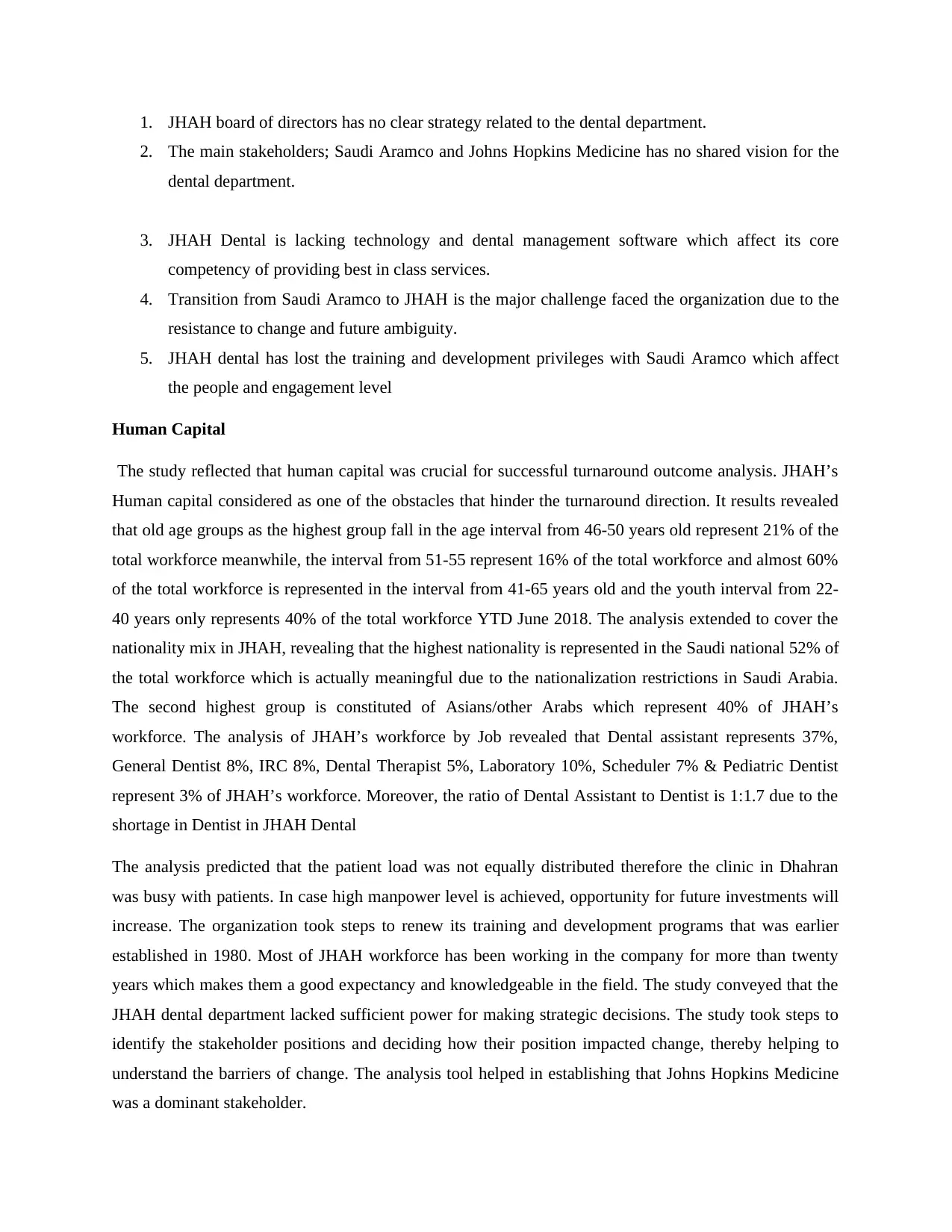
1. JHAH board of directors has no clear strategy related to the dental department.
2. The main stakeholders; Saudi Aramco and Johns Hopkins Medicine has no shared vision for the
dental department.
3. JHAH Dental is lacking technology and dental management software which affect its core
competency of providing best in class services.
4. Transition from Saudi Aramco to JHAH is the major challenge faced the organization due to the
resistance to change and future ambiguity.
5. JHAH dental has lost the training and development privileges with Saudi Aramco which affect
the people and engagement level
Human Capital
The study reflected that human capital was crucial for successful turnaround outcome analysis. JHAH’s
Human capital considered as one of the obstacles that hinder the turnaround direction. It results revealed
that old age groups as the highest group fall in the age interval from 46-50 years old represent 21% of the
total workforce meanwhile, the interval from 51-55 represent 16% of the total workforce and almost 60%
of the total workforce is represented in the interval from 41-65 years old and the youth interval from 22-
40 years only represents 40% of the total workforce YTD June 2018. The analysis extended to cover the
nationality mix in JHAH, revealing that the highest nationality is represented in the Saudi national 52% of
the total workforce which is actually meaningful due to the nationalization restrictions in Saudi Arabia.
The second highest group is constituted of Asians/other Arabs which represent 40% of JHAH’s
workforce. The analysis of JHAH’s workforce by Job revealed that Dental assistant represents 37%,
General Dentist 8%, IRC 8%, Dental Therapist 5%, Laboratory 10%, Scheduler 7% & Pediatric Dentist
represent 3% of JHAH’s workforce. Moreover, the ratio of Dental Assistant to Dentist is 1:1.7 due to the
shortage in Dentist in JHAH Dental
The analysis predicted that the patient load was not equally distributed therefore the clinic in Dhahran
was busy with patients. In case high manpower level is achieved, opportunity for future investments will
increase. The organization took steps to renew its training and development programs that was earlier
established in 1980. Most of JHAH workforce has been working in the company for more than twenty
years which makes them a good expectancy and knowledgeable in the field. The study conveyed that the
JHAH dental department lacked sufficient power for making strategic decisions. The study took steps to
identify the stakeholder positions and deciding how their position impacted change, thereby helping to
understand the barriers of change. The analysis tool helped in establishing that Johns Hopkins Medicine
was a dominant stakeholder.
2. The main stakeholders; Saudi Aramco and Johns Hopkins Medicine has no shared vision for the
dental department.
3. JHAH Dental is lacking technology and dental management software which affect its core
competency of providing best in class services.
4. Transition from Saudi Aramco to JHAH is the major challenge faced the organization due to the
resistance to change and future ambiguity.
5. JHAH dental has lost the training and development privileges with Saudi Aramco which affect
the people and engagement level
Human Capital
The study reflected that human capital was crucial for successful turnaround outcome analysis. JHAH’s
Human capital considered as one of the obstacles that hinder the turnaround direction. It results revealed
that old age groups as the highest group fall in the age interval from 46-50 years old represent 21% of the
total workforce meanwhile, the interval from 51-55 represent 16% of the total workforce and almost 60%
of the total workforce is represented in the interval from 41-65 years old and the youth interval from 22-
40 years only represents 40% of the total workforce YTD June 2018. The analysis extended to cover the
nationality mix in JHAH, revealing that the highest nationality is represented in the Saudi national 52% of
the total workforce which is actually meaningful due to the nationalization restrictions in Saudi Arabia.
The second highest group is constituted of Asians/other Arabs which represent 40% of JHAH’s
workforce. The analysis of JHAH’s workforce by Job revealed that Dental assistant represents 37%,
General Dentist 8%, IRC 8%, Dental Therapist 5%, Laboratory 10%, Scheduler 7% & Pediatric Dentist
represent 3% of JHAH’s workforce. Moreover, the ratio of Dental Assistant to Dentist is 1:1.7 due to the
shortage in Dentist in JHAH Dental
The analysis predicted that the patient load was not equally distributed therefore the clinic in Dhahran
was busy with patients. In case high manpower level is achieved, opportunity for future investments will
increase. The organization took steps to renew its training and development programs that was earlier
established in 1980. Most of JHAH workforce has been working in the company for more than twenty
years which makes them a good expectancy and knowledgeable in the field. The study conveyed that the
JHAH dental department lacked sufficient power for making strategic decisions. The study took steps to
identify the stakeholder positions and deciding how their position impacted change, thereby helping to
understand the barriers of change. The analysis tool helped in establishing that Johns Hopkins Medicine
was a dominant stakeholder.
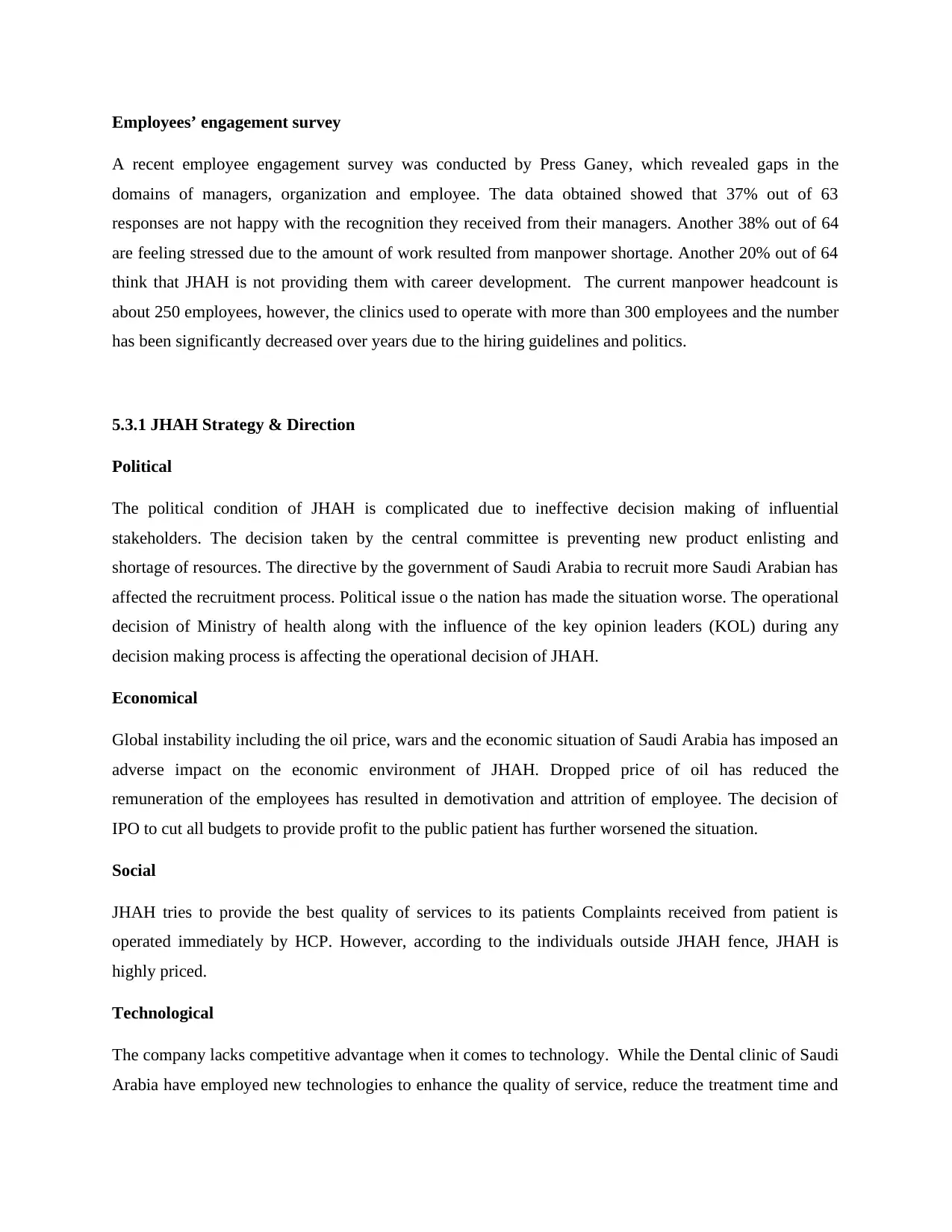
Employees’ engagement survey
A recent employee engagement survey was conducted by Press Ganey, which revealed gaps in the
domains of managers, organization and employee. The data obtained showed that 37% out of 63
responses are not happy with the recognition they received from their managers. Another 38% out of 64
are feeling stressed due to the amount of work resulted from manpower shortage. Another 20% out of 64
think that JHAH is not providing them with career development. The current manpower headcount is
about 250 employees, however, the clinics used to operate with more than 300 employees and the number
has been significantly decreased over years due to the hiring guidelines and politics.
5.3.1 JHAH Strategy & Direction
Political
The political condition of JHAH is complicated due to ineffective decision making of influential
stakeholders. The decision taken by the central committee is preventing new product enlisting and
shortage of resources. The directive by the government of Saudi Arabia to recruit more Saudi Arabian has
affected the recruitment process. Political issue o the nation has made the situation worse. The operational
decision of Ministry of health along with the influence of the key opinion leaders (KOL) during any
decision making process is affecting the operational decision of JHAH.
Economical
Global instability including the oil price, wars and the economic situation of Saudi Arabia has imposed an
adverse impact on the economic environment of JHAH. Dropped price of oil has reduced the
remuneration of the employees has resulted in demotivation and attrition of employee. The decision of
IPO to cut all budgets to provide profit to the public patient has further worsened the situation.
Social
JHAH tries to provide the best quality of services to its patients Complaints received from patient is
operated immediately by HCP. However, according to the individuals outside JHAH fence, JHAH is
highly priced.
Technological
The company lacks competitive advantage when it comes to technology. While the Dental clinic of Saudi
Arabia have employed new technologies to enhance the quality of service, reduce the treatment time and
A recent employee engagement survey was conducted by Press Ganey, which revealed gaps in the
domains of managers, organization and employee. The data obtained showed that 37% out of 63
responses are not happy with the recognition they received from their managers. Another 38% out of 64
are feeling stressed due to the amount of work resulted from manpower shortage. Another 20% out of 64
think that JHAH is not providing them with career development. The current manpower headcount is
about 250 employees, however, the clinics used to operate with more than 300 employees and the number
has been significantly decreased over years due to the hiring guidelines and politics.
5.3.1 JHAH Strategy & Direction
Political
The political condition of JHAH is complicated due to ineffective decision making of influential
stakeholders. The decision taken by the central committee is preventing new product enlisting and
shortage of resources. The directive by the government of Saudi Arabia to recruit more Saudi Arabian has
affected the recruitment process. Political issue o the nation has made the situation worse. The operational
decision of Ministry of health along with the influence of the key opinion leaders (KOL) during any
decision making process is affecting the operational decision of JHAH.
Economical
Global instability including the oil price, wars and the economic situation of Saudi Arabia has imposed an
adverse impact on the economic environment of JHAH. Dropped price of oil has reduced the
remuneration of the employees has resulted in demotivation and attrition of employee. The decision of
IPO to cut all budgets to provide profit to the public patient has further worsened the situation.
Social
JHAH tries to provide the best quality of services to its patients Complaints received from patient is
operated immediately by HCP. However, according to the individuals outside JHAH fence, JHAH is
highly priced.
Technological
The company lacks competitive advantage when it comes to technology. While the Dental clinic of Saudi
Arabia have employed new technologies to enhance the quality of service, reduce the treatment time and
⊘ This is a preview!⊘
Do you want full access?
Subscribe today to unlock all pages.

Trusted by 1+ million students worldwide
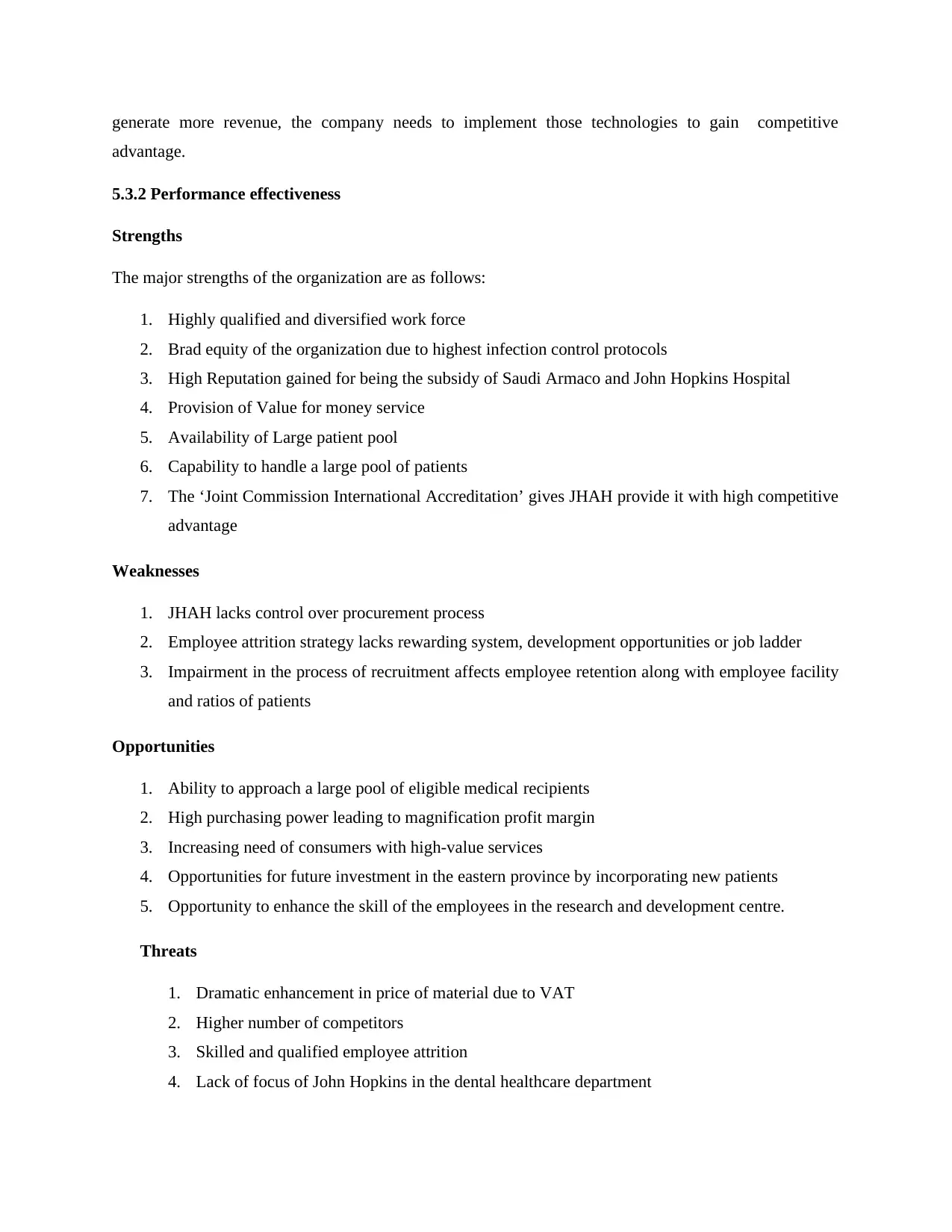
generate more revenue, the company needs to implement those technologies to gain competitive
advantage.
5.3.2 Performance effectiveness
Strengths
The major strengths of the organization are as follows:
1. Highly qualified and diversified work force
2. Brad equity of the organization due to highest infection control protocols
3. High Reputation gained for being the subsidy of Saudi Armaco and John Hopkins Hospital
4. Provision of Value for money service
5. Availability of Large patient pool
6. Capability to handle a large pool of patients
7. The ‘Joint Commission International Accreditation’ gives JHAH provide it with high competitive
advantage
Weaknesses
1. JHAH lacks control over procurement process
2. Employee attrition strategy lacks rewarding system, development opportunities or job ladder
3. Impairment in the process of recruitment affects employee retention along with employee facility
and ratios of patients
Opportunities
1. Ability to approach a large pool of eligible medical recipients
2. High purchasing power leading to magnification profit margin
3. Increasing need of consumers with high-value services
4. Opportunities for future investment in the eastern province by incorporating new patients
5. Opportunity to enhance the skill of the employees in the research and development centre.
Threats
1. Dramatic enhancement in price of material due to VAT
2. Higher number of competitors
3. Skilled and qualified employee attrition
4. Lack of focus of John Hopkins in the dental healthcare department
advantage.
5.3.2 Performance effectiveness
Strengths
The major strengths of the organization are as follows:
1. Highly qualified and diversified work force
2. Brad equity of the organization due to highest infection control protocols
3. High Reputation gained for being the subsidy of Saudi Armaco and John Hopkins Hospital
4. Provision of Value for money service
5. Availability of Large patient pool
6. Capability to handle a large pool of patients
7. The ‘Joint Commission International Accreditation’ gives JHAH provide it with high competitive
advantage
Weaknesses
1. JHAH lacks control over procurement process
2. Employee attrition strategy lacks rewarding system, development opportunities or job ladder
3. Impairment in the process of recruitment affects employee retention along with employee facility
and ratios of patients
Opportunities
1. Ability to approach a large pool of eligible medical recipients
2. High purchasing power leading to magnification profit margin
3. Increasing need of consumers with high-value services
4. Opportunities for future investment in the eastern province by incorporating new patients
5. Opportunity to enhance the skill of the employees in the research and development centre.
Threats
1. Dramatic enhancement in price of material due to VAT
2. Higher number of competitors
3. Skilled and qualified employee attrition
4. Lack of focus of John Hopkins in the dental healthcare department
Paraphrase This Document
Need a fresh take? Get an instant paraphrase of this document with our AI Paraphraser
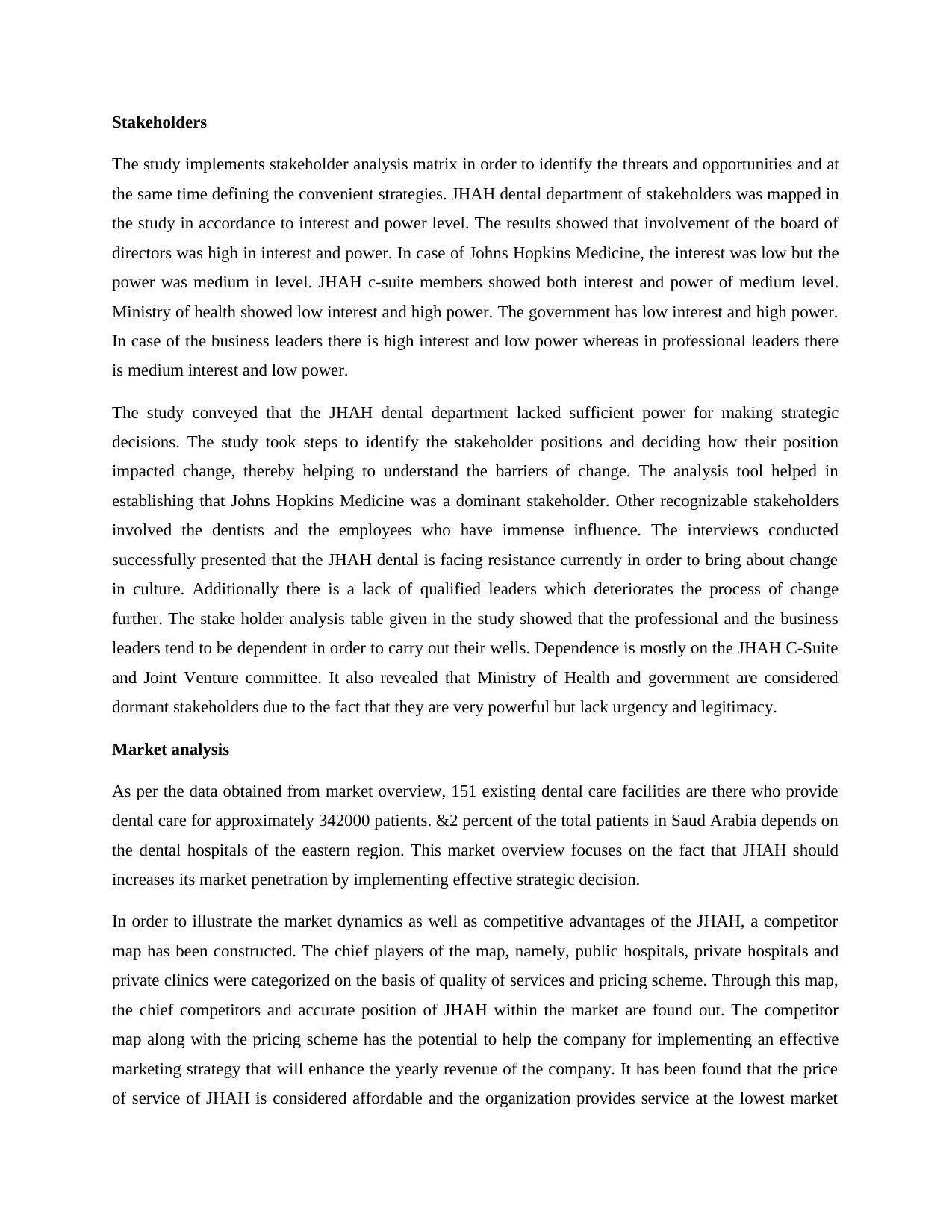
Stakeholders
The study implements stakeholder analysis matrix in order to identify the threats and opportunities and at
the same time defining the convenient strategies. JHAH dental department of stakeholders was mapped in
the study in accordance to interest and power level. The results showed that involvement of the board of
directors was high in interest and power. In case of Johns Hopkins Medicine, the interest was low but the
power was medium in level. JHAH c-suite members showed both interest and power of medium level.
Ministry of health showed low interest and high power. The government has low interest and high power.
In case of the business leaders there is high interest and low power whereas in professional leaders there
is medium interest and low power.
The study conveyed that the JHAH dental department lacked sufficient power for making strategic
decisions. The study took steps to identify the stakeholder positions and deciding how their position
impacted change, thereby helping to understand the barriers of change. The analysis tool helped in
establishing that Johns Hopkins Medicine was a dominant stakeholder. Other recognizable stakeholders
involved the dentists and the employees who have immense influence. The interviews conducted
successfully presented that the JHAH dental is facing resistance currently in order to bring about change
in culture. Additionally there is a lack of qualified leaders which deteriorates the process of change
further. The stake holder analysis table given in the study showed that the professional and the business
leaders tend to be dependent in order to carry out their wells. Dependence is mostly on the JHAH C-Suite
and Joint Venture committee. It also revealed that Ministry of Health and government are considered
dormant stakeholders due to the fact that they are very powerful but lack urgency and legitimacy.
Market analysis
As per the data obtained from market overview, 151 existing dental care facilities are there who provide
dental care for approximately 342000 patients. &2 percent of the total patients in Saud Arabia depends on
the dental hospitals of the eastern region. This market overview focuses on the fact that JHAH should
increases its market penetration by implementing effective strategic decision.
In order to illustrate the market dynamics as well as competitive advantages of the JHAH, a competitor
map has been constructed. The chief players of the map, namely, public hospitals, private hospitals and
private clinics were categorized on the basis of quality of services and pricing scheme. Through this map,
the chief competitors and accurate position of JHAH within the market are found out. The competitor
map along with the pricing scheme has the potential to help the company for implementing an effective
marketing strategy that will enhance the yearly revenue of the company. It has been found that the price
of service of JHAH is considered affordable and the organization provides service at the lowest market
The study implements stakeholder analysis matrix in order to identify the threats and opportunities and at
the same time defining the convenient strategies. JHAH dental department of stakeholders was mapped in
the study in accordance to interest and power level. The results showed that involvement of the board of
directors was high in interest and power. In case of Johns Hopkins Medicine, the interest was low but the
power was medium in level. JHAH c-suite members showed both interest and power of medium level.
Ministry of health showed low interest and high power. The government has low interest and high power.
In case of the business leaders there is high interest and low power whereas in professional leaders there
is medium interest and low power.
The study conveyed that the JHAH dental department lacked sufficient power for making strategic
decisions. The study took steps to identify the stakeholder positions and deciding how their position
impacted change, thereby helping to understand the barriers of change. The analysis tool helped in
establishing that Johns Hopkins Medicine was a dominant stakeholder. Other recognizable stakeholders
involved the dentists and the employees who have immense influence. The interviews conducted
successfully presented that the JHAH dental is facing resistance currently in order to bring about change
in culture. Additionally there is a lack of qualified leaders which deteriorates the process of change
further. The stake holder analysis table given in the study showed that the professional and the business
leaders tend to be dependent in order to carry out their wells. Dependence is mostly on the JHAH C-Suite
and Joint Venture committee. It also revealed that Ministry of Health and government are considered
dormant stakeholders due to the fact that they are very powerful but lack urgency and legitimacy.
Market analysis
As per the data obtained from market overview, 151 existing dental care facilities are there who provide
dental care for approximately 342000 patients. &2 percent of the total patients in Saud Arabia depends on
the dental hospitals of the eastern region. This market overview focuses on the fact that JHAH should
increases its market penetration by implementing effective strategic decision.
In order to illustrate the market dynamics as well as competitive advantages of the JHAH, a competitor
map has been constructed. The chief players of the map, namely, public hospitals, private hospitals and
private clinics were categorized on the basis of quality of services and pricing scheme. Through this map,
the chief competitors and accurate position of JHAH within the market are found out. The competitor
map along with the pricing scheme has the potential to help the company for implementing an effective
marketing strategy that will enhance the yearly revenue of the company. It has been found that the price
of service of JHAH is considered affordable and the organization provides service at the lowest market
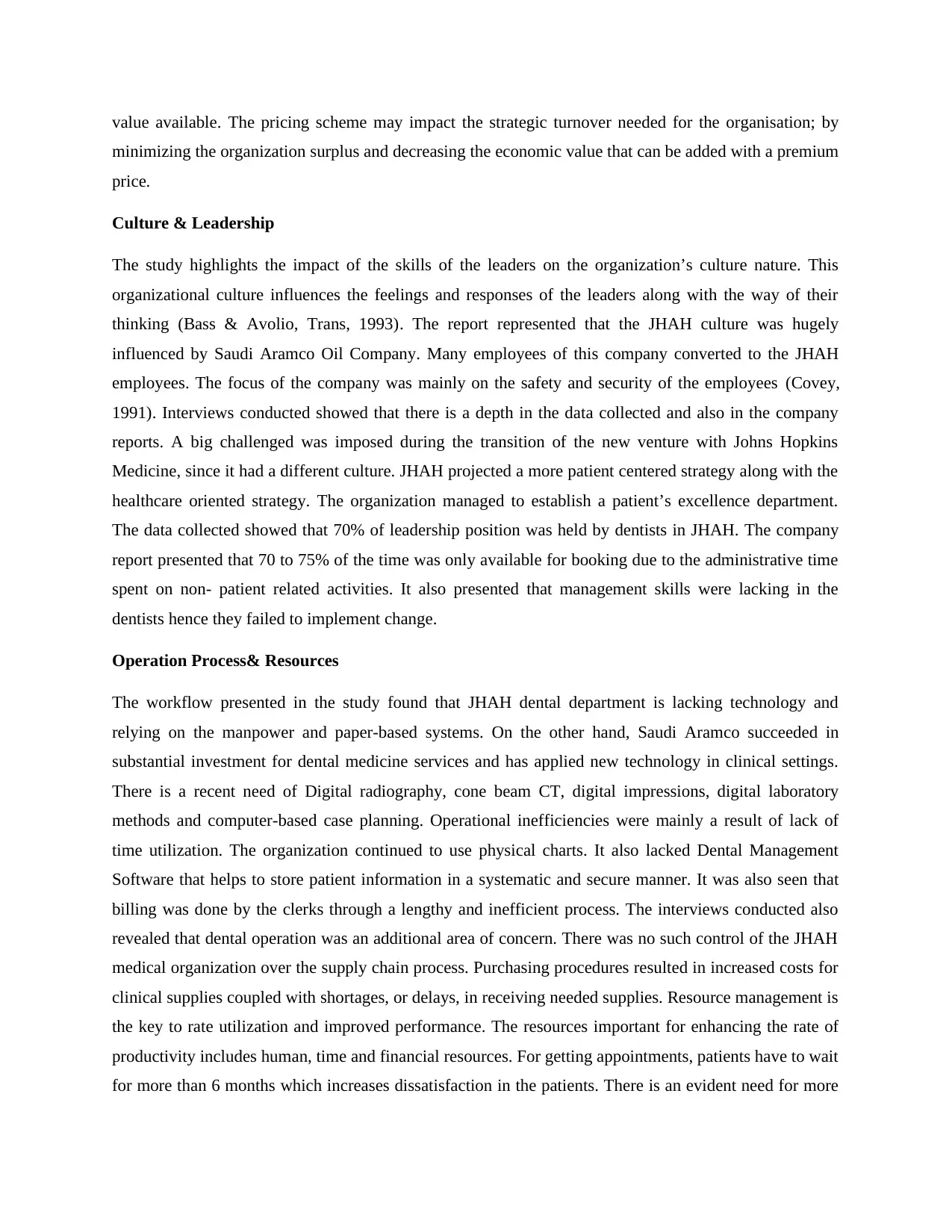
value available. The pricing scheme may impact the strategic turnover needed for the organisation; by
minimizing the organization surplus and decreasing the economic value that can be added with a premium
price.
Culture & Leadership
The study highlights the impact of the skills of the leaders on the organization’s culture nature. This
organizational culture influences the feelings and responses of the leaders along with the way of their
thinking (Bass & Avolio, Trans, 1993). The report represented that the JHAH culture was hugely
influenced by Saudi Aramco Oil Company. Many employees of this company converted to the JHAH
employees. The focus of the company was mainly on the safety and security of the employees (Covey,
1991). Interviews conducted showed that there is a depth in the data collected and also in the company
reports. A big challenged was imposed during the transition of the new venture with Johns Hopkins
Medicine, since it had a different culture. JHAH projected a more patient centered strategy along with the
healthcare oriented strategy. The organization managed to establish a patient’s excellence department.
The data collected showed that 70% of leadership position was held by dentists in JHAH. The company
report presented that 70 to 75% of the time was only available for booking due to the administrative time
spent on non- patient related activities. It also presented that management skills were lacking in the
dentists hence they failed to implement change.
Operation Process& Resources
The workflow presented in the study found that JHAH dental department is lacking technology and
relying on the manpower and paper-based systems. On the other hand, Saudi Aramco succeeded in
substantial investment for dental medicine services and has applied new technology in clinical settings.
There is a recent need of Digital radiography, cone beam CT, digital impressions, digital laboratory
methods and computer-based case planning. Operational inefficiencies were mainly a result of lack of
time utilization. The organization continued to use physical charts. It also lacked Dental Management
Software that helps to store patient information in a systematic and secure manner. It was also seen that
billing was done by the clerks through a lengthy and inefficient process. The interviews conducted also
revealed that dental operation was an additional area of concern. There was no such control of the JHAH
medical organization over the supply chain process. Purchasing procedures resulted in increased costs for
clinical supplies coupled with shortages, or delays, in receiving needed supplies. Resource management is
the key to rate utilization and improved performance. The resources important for enhancing the rate of
productivity includes human, time and financial resources. For getting appointments, patients have to wait
for more than 6 months which increases dissatisfaction in the patients. There is an evident need for more
minimizing the organization surplus and decreasing the economic value that can be added with a premium
price.
Culture & Leadership
The study highlights the impact of the skills of the leaders on the organization’s culture nature. This
organizational culture influences the feelings and responses of the leaders along with the way of their
thinking (Bass & Avolio, Trans, 1993). The report represented that the JHAH culture was hugely
influenced by Saudi Aramco Oil Company. Many employees of this company converted to the JHAH
employees. The focus of the company was mainly on the safety and security of the employees (Covey,
1991). Interviews conducted showed that there is a depth in the data collected and also in the company
reports. A big challenged was imposed during the transition of the new venture with Johns Hopkins
Medicine, since it had a different culture. JHAH projected a more patient centered strategy along with the
healthcare oriented strategy. The organization managed to establish a patient’s excellence department.
The data collected showed that 70% of leadership position was held by dentists in JHAH. The company
report presented that 70 to 75% of the time was only available for booking due to the administrative time
spent on non- patient related activities. It also presented that management skills were lacking in the
dentists hence they failed to implement change.
Operation Process& Resources
The workflow presented in the study found that JHAH dental department is lacking technology and
relying on the manpower and paper-based systems. On the other hand, Saudi Aramco succeeded in
substantial investment for dental medicine services and has applied new technology in clinical settings.
There is a recent need of Digital radiography, cone beam CT, digital impressions, digital laboratory
methods and computer-based case planning. Operational inefficiencies were mainly a result of lack of
time utilization. The organization continued to use physical charts. It also lacked Dental Management
Software that helps to store patient information in a systematic and secure manner. It was also seen that
billing was done by the clerks through a lengthy and inefficient process. The interviews conducted also
revealed that dental operation was an additional area of concern. There was no such control of the JHAH
medical organization over the supply chain process. Purchasing procedures resulted in increased costs for
clinical supplies coupled with shortages, or delays, in receiving needed supplies. Resource management is
the key to rate utilization and improved performance. The resources important for enhancing the rate of
productivity includes human, time and financial resources. For getting appointments, patients have to wait
for more than 6 months which increases dissatisfaction in the patients. There is an evident need for more
⊘ This is a preview!⊘
Do you want full access?
Subscribe today to unlock all pages.

Trusted by 1+ million students worldwide
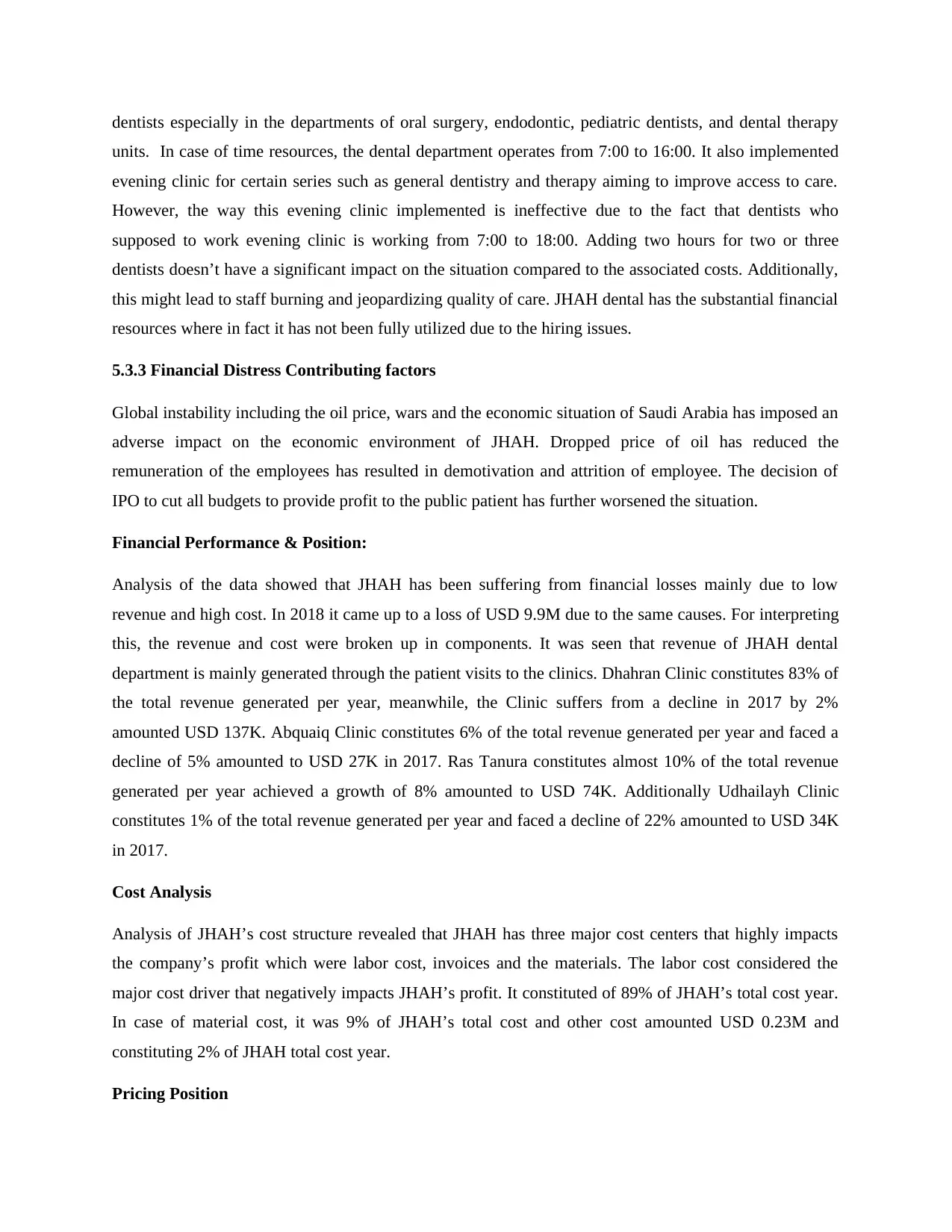
dentists especially in the departments of oral surgery, endodontic, pediatric dentists, and dental therapy
units. In case of time resources, the dental department operates from 7:00 to 16:00. It also implemented
evening clinic for certain series such as general dentistry and therapy aiming to improve access to care.
However, the way this evening clinic implemented is ineffective due to the fact that dentists who
supposed to work evening clinic is working from 7:00 to 18:00. Adding two hours for two or three
dentists doesn’t have a significant impact on the situation compared to the associated costs. Additionally,
this might lead to staff burning and jeopardizing quality of care. JHAH dental has the substantial financial
resources where in fact it has not been fully utilized due to the hiring issues.
5.3.3 Financial Distress Contributing factors
Global instability including the oil price, wars and the economic situation of Saudi Arabia has imposed an
adverse impact on the economic environment of JHAH. Dropped price of oil has reduced the
remuneration of the employees has resulted in demotivation and attrition of employee. The decision of
IPO to cut all budgets to provide profit to the public patient has further worsened the situation.
Financial Performance & Position:
Analysis of the data showed that JHAH has been suffering from financial losses mainly due to low
revenue and high cost. In 2018 it came up to a loss of USD 9.9M due to the same causes. For interpreting
this, the revenue and cost were broken up in components. It was seen that revenue of JHAH dental
department is mainly generated through the patient visits to the clinics. Dhahran Clinic constitutes 83% of
the total revenue generated per year, meanwhile, the Clinic suffers from a decline in 2017 by 2%
amounted USD 137K. Abquaiq Clinic constitutes 6% of the total revenue generated per year and faced a
decline of 5% amounted to USD 27K in 2017. Ras Tanura constitutes almost 10% of the total revenue
generated per year achieved a growth of 8% amounted to USD 74K. Additionally Udhailayh Clinic
constitutes 1% of the total revenue generated per year and faced a decline of 22% amounted to USD 34K
in 2017.
Cost Analysis
Analysis of JHAH’s cost structure revealed that JHAH has three major cost centers that highly impacts
the company’s profit which were labor cost, invoices and the materials. The labor cost considered the
major cost driver that negatively impacts JHAH’s profit. It constituted of 89% of JHAH’s total cost year.
In case of material cost, it was 9% of JHAH’s total cost and other cost amounted USD 0.23M and
constituting 2% of JHAH total cost year.
Pricing Position
units. In case of time resources, the dental department operates from 7:00 to 16:00. It also implemented
evening clinic for certain series such as general dentistry and therapy aiming to improve access to care.
However, the way this evening clinic implemented is ineffective due to the fact that dentists who
supposed to work evening clinic is working from 7:00 to 18:00. Adding two hours for two or three
dentists doesn’t have a significant impact on the situation compared to the associated costs. Additionally,
this might lead to staff burning and jeopardizing quality of care. JHAH dental has the substantial financial
resources where in fact it has not been fully utilized due to the hiring issues.
5.3.3 Financial Distress Contributing factors
Global instability including the oil price, wars and the economic situation of Saudi Arabia has imposed an
adverse impact on the economic environment of JHAH. Dropped price of oil has reduced the
remuneration of the employees has resulted in demotivation and attrition of employee. The decision of
IPO to cut all budgets to provide profit to the public patient has further worsened the situation.
Financial Performance & Position:
Analysis of the data showed that JHAH has been suffering from financial losses mainly due to low
revenue and high cost. In 2018 it came up to a loss of USD 9.9M due to the same causes. For interpreting
this, the revenue and cost were broken up in components. It was seen that revenue of JHAH dental
department is mainly generated through the patient visits to the clinics. Dhahran Clinic constitutes 83% of
the total revenue generated per year, meanwhile, the Clinic suffers from a decline in 2017 by 2%
amounted USD 137K. Abquaiq Clinic constitutes 6% of the total revenue generated per year and faced a
decline of 5% amounted to USD 27K in 2017. Ras Tanura constitutes almost 10% of the total revenue
generated per year achieved a growth of 8% amounted to USD 74K. Additionally Udhailayh Clinic
constitutes 1% of the total revenue generated per year and faced a decline of 22% amounted to USD 34K
in 2017.
Cost Analysis
Analysis of JHAH’s cost structure revealed that JHAH has three major cost centers that highly impacts
the company’s profit which were labor cost, invoices and the materials. The labor cost considered the
major cost driver that negatively impacts JHAH’s profit. It constituted of 89% of JHAH’s total cost year.
In case of material cost, it was 9% of JHAH’s total cost and other cost amounted USD 0.23M and
constituting 2% of JHAH total cost year.
Pricing Position
Paraphrase This Document
Need a fresh take? Get an instant paraphrase of this document with our AI Paraphraser
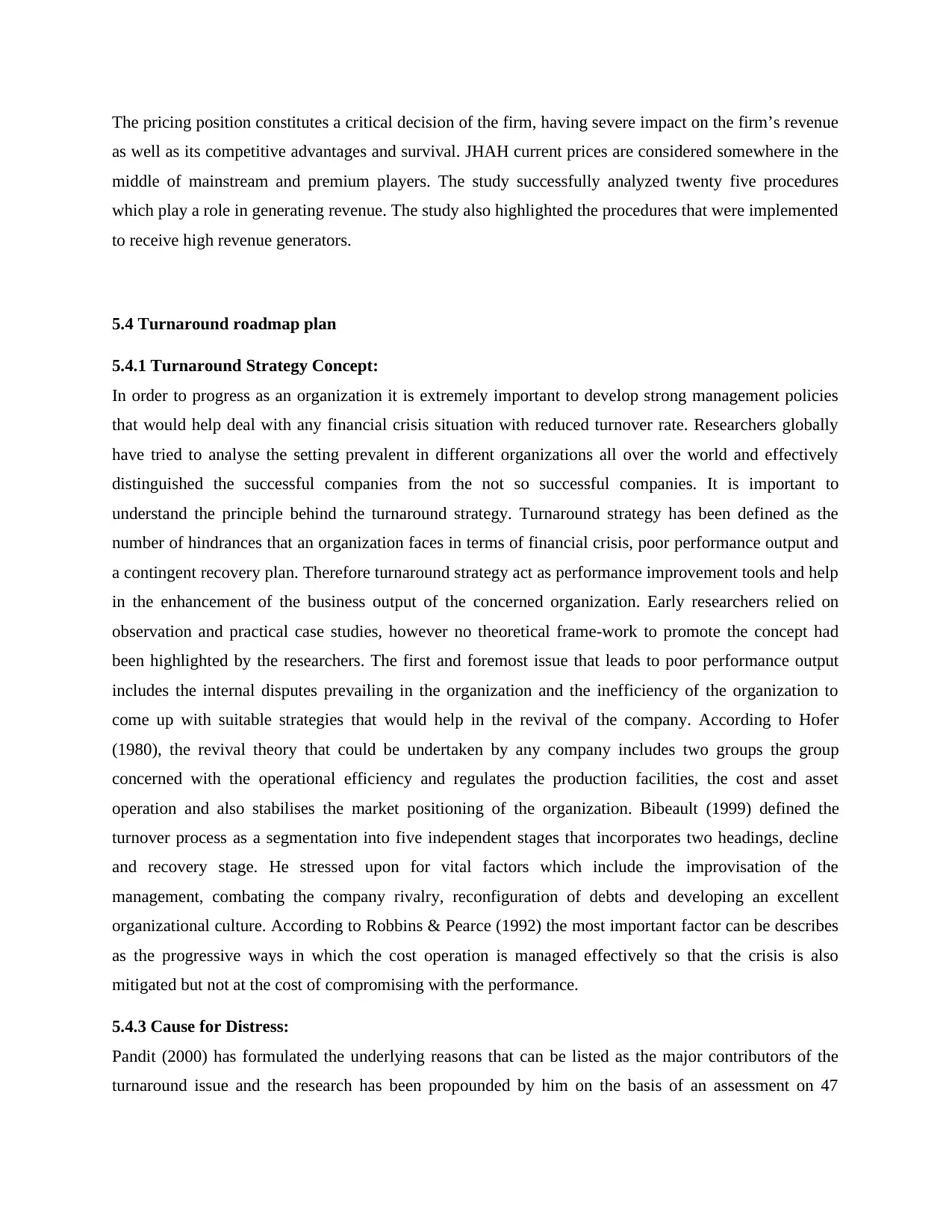
The pricing position constitutes a critical decision of the firm, having severe impact on the firm’s revenue
as well as its competitive advantages and survival. JHAH current prices are considered somewhere in the
middle of mainstream and premium players. The study successfully analyzed twenty five procedures
which play a role in generating revenue. The study also highlighted the procedures that were implemented
to receive high revenue generators.
5.4 Turnaround roadmap plan
5.4.1 Turnaround Strategy Concept:
In order to progress as an organization it is extremely important to develop strong management policies
that would help deal with any financial crisis situation with reduced turnover rate. Researchers globally
have tried to analyse the setting prevalent in different organizations all over the world and effectively
distinguished the successful companies from the not so successful companies. It is important to
understand the principle behind the turnaround strategy. Turnaround strategy has been defined as the
number of hindrances that an organization faces in terms of financial crisis, poor performance output and
a contingent recovery plan. Therefore turnaround strategy act as performance improvement tools and help
in the enhancement of the business output of the concerned organization. Early researchers relied on
observation and practical case studies, however no theoretical frame-work to promote the concept had
been highlighted by the researchers. The first and foremost issue that leads to poor performance output
includes the internal disputes prevailing in the organization and the inefficiency of the organization to
come up with suitable strategies that would help in the revival of the company. According to Hofer
(1980), the revival theory that could be undertaken by any company includes two groups the group
concerned with the operational efficiency and regulates the production facilities, the cost and asset
operation and also stabilises the market positioning of the organization. Bibeault (1999) defined the
turnover process as a segmentation into five independent stages that incorporates two headings, decline
and recovery stage. He stressed upon for vital factors which include the improvisation of the
management, combating the company rivalry, reconfiguration of debts and developing an excellent
organizational culture. According to Robbins & Pearce (1992) the most important factor can be describes
as the progressive ways in which the cost operation is managed effectively so that the crisis is also
mitigated but not at the cost of compromising with the performance.
5.4.3 Cause for Distress:
Pandit (2000) has formulated the underlying reasons that can be listed as the major contributors of the
turnaround issue and the research has been propounded by him on the basis of an assessment on 47
as well as its competitive advantages and survival. JHAH current prices are considered somewhere in the
middle of mainstream and premium players. The study successfully analyzed twenty five procedures
which play a role in generating revenue. The study also highlighted the procedures that were implemented
to receive high revenue generators.
5.4 Turnaround roadmap plan
5.4.1 Turnaround Strategy Concept:
In order to progress as an organization it is extremely important to develop strong management policies
that would help deal with any financial crisis situation with reduced turnover rate. Researchers globally
have tried to analyse the setting prevalent in different organizations all over the world and effectively
distinguished the successful companies from the not so successful companies. It is important to
understand the principle behind the turnaround strategy. Turnaround strategy has been defined as the
number of hindrances that an organization faces in terms of financial crisis, poor performance output and
a contingent recovery plan. Therefore turnaround strategy act as performance improvement tools and help
in the enhancement of the business output of the concerned organization. Early researchers relied on
observation and practical case studies, however no theoretical frame-work to promote the concept had
been highlighted by the researchers. The first and foremost issue that leads to poor performance output
includes the internal disputes prevailing in the organization and the inefficiency of the organization to
come up with suitable strategies that would help in the revival of the company. According to Hofer
(1980), the revival theory that could be undertaken by any company includes two groups the group
concerned with the operational efficiency and regulates the production facilities, the cost and asset
operation and also stabilises the market positioning of the organization. Bibeault (1999) defined the
turnover process as a segmentation into five independent stages that incorporates two headings, decline
and recovery stage. He stressed upon for vital factors which include the improvisation of the
management, combating the company rivalry, reconfiguration of debts and developing an excellent
organizational culture. According to Robbins & Pearce (1992) the most important factor can be describes
as the progressive ways in which the cost operation is managed effectively so that the crisis is also
mitigated but not at the cost of compromising with the performance.
5.4.3 Cause for Distress:
Pandit (2000) has formulated the underlying reasons that can be listed as the major contributors of the
turnaround issue and the research has been propounded by him on the basis of an assessment on 47
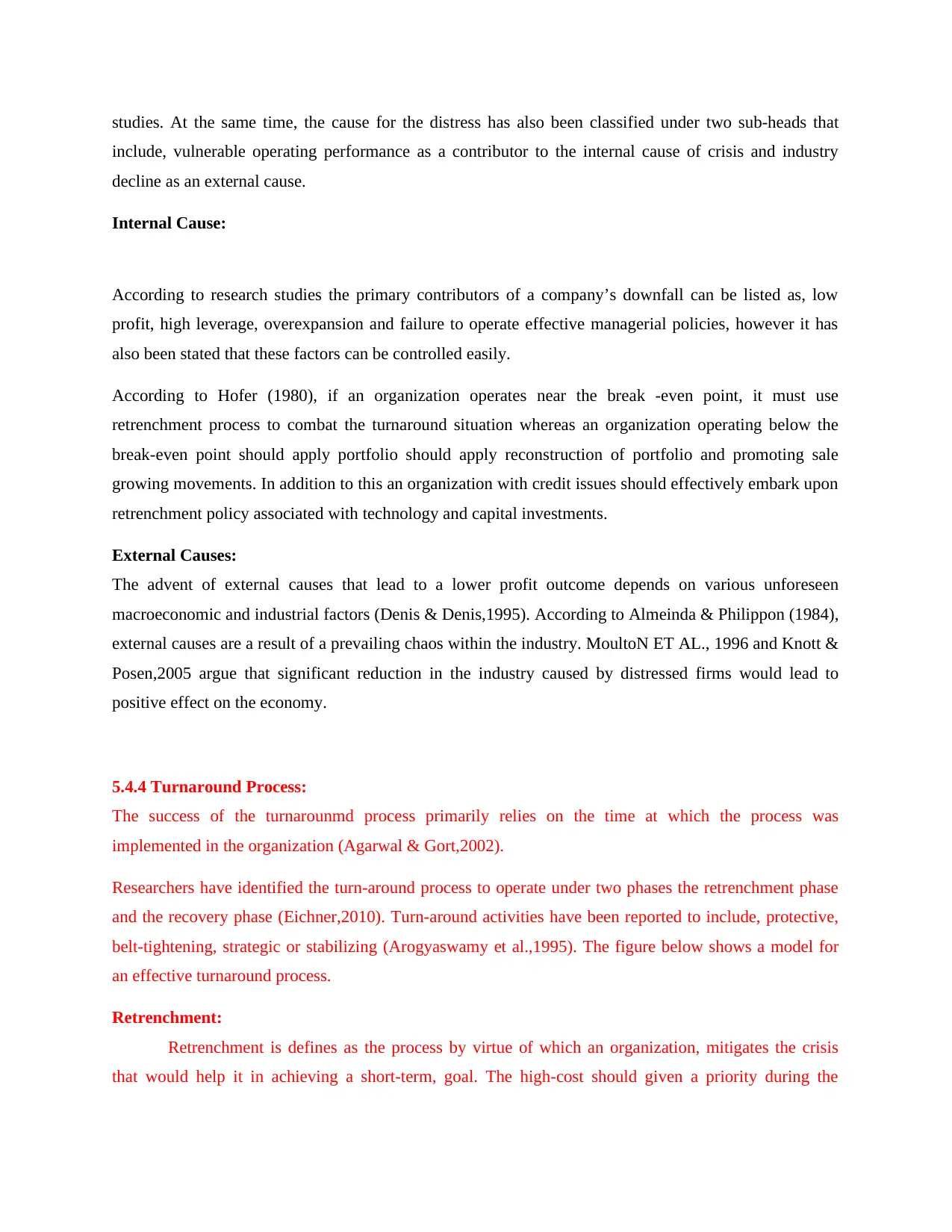
studies. At the same time, the cause for the distress has also been classified under two sub-heads that
include, vulnerable operating performance as a contributor to the internal cause of crisis and industry
decline as an external cause.
Internal Cause:
According to research studies the primary contributors of a company’s downfall can be listed as, low
profit, high leverage, overexpansion and failure to operate effective managerial policies, however it has
also been stated that these factors can be controlled easily.
According to Hofer (1980), if an organization operates near the break -even point, it must use
retrenchment process to combat the turnaround situation whereas an organization operating below the
break-even point should apply portfolio should apply reconstruction of portfolio and promoting sale
growing movements. In addition to this an organization with credit issues should effectively embark upon
retrenchment policy associated with technology and capital investments.
External Causes:
The advent of external causes that lead to a lower profit outcome depends on various unforeseen
macroeconomic and industrial factors (Denis & Denis,1995). According to Almeinda & Philippon (1984),
external causes are a result of a prevailing chaos within the industry. MoultoN ET AL., 1996 and Knott &
Posen,2005 argue that significant reduction in the industry caused by distressed firms would lead to
positive effect on the economy.
5.4.4 Turnaround Process:
The success of the turnarounmd process primarily relies on the time at which the process was
implemented in the organization (Agarwal & Gort,2002).
Researchers have identified the turn-around process to operate under two phases the retrenchment phase
and the recovery phase (Eichner,2010). Turn-around activities have been reported to include, protective,
belt-tightening, strategic or stabilizing (Arogyaswamy et al.,1995). The figure below shows a model for
an effective turnaround process.
Retrenchment:
Retrenchment is defines as the process by virtue of which an organization, mitigates the crisis
that would help it in achieving a short-term, goal. The high-cost should given a priority during the
include, vulnerable operating performance as a contributor to the internal cause of crisis and industry
decline as an external cause.
Internal Cause:
According to research studies the primary contributors of a company’s downfall can be listed as, low
profit, high leverage, overexpansion and failure to operate effective managerial policies, however it has
also been stated that these factors can be controlled easily.
According to Hofer (1980), if an organization operates near the break -even point, it must use
retrenchment process to combat the turnaround situation whereas an organization operating below the
break-even point should apply portfolio should apply reconstruction of portfolio and promoting sale
growing movements. In addition to this an organization with credit issues should effectively embark upon
retrenchment policy associated with technology and capital investments.
External Causes:
The advent of external causes that lead to a lower profit outcome depends on various unforeseen
macroeconomic and industrial factors (Denis & Denis,1995). According to Almeinda & Philippon (1984),
external causes are a result of a prevailing chaos within the industry. MoultoN ET AL., 1996 and Knott &
Posen,2005 argue that significant reduction in the industry caused by distressed firms would lead to
positive effect on the economy.
5.4.4 Turnaround Process:
The success of the turnarounmd process primarily relies on the time at which the process was
implemented in the organization (Agarwal & Gort,2002).
Researchers have identified the turn-around process to operate under two phases the retrenchment phase
and the recovery phase (Eichner,2010). Turn-around activities have been reported to include, protective,
belt-tightening, strategic or stabilizing (Arogyaswamy et al.,1995). The figure below shows a model for
an effective turnaround process.
Retrenchment:
Retrenchment is defines as the process by virtue of which an organization, mitigates the crisis
that would help it in achieving a short-term, goal. The high-cost should given a priority during the
⊘ This is a preview!⊘
Do you want full access?
Subscribe today to unlock all pages.

Trusted by 1+ million students worldwide
1 out of 21
Related Documents
Your All-in-One AI-Powered Toolkit for Academic Success.
+13062052269
info@desklib.com
Available 24*7 on WhatsApp / Email
![[object Object]](/_next/static/media/star-bottom.7253800d.svg)
Unlock your academic potential
Copyright © 2020–2025 A2Z Services. All Rights Reserved. Developed and managed by ZUCOL.





